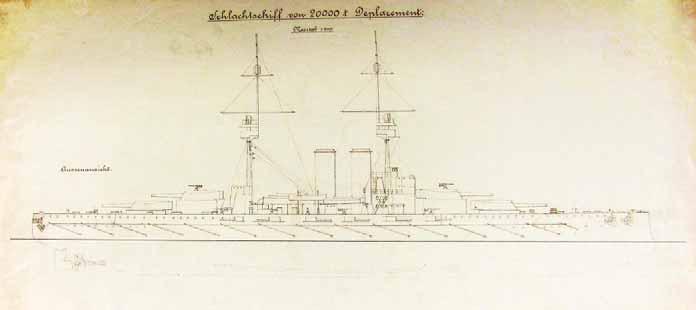the launch Franz Ferdinand revoked his participation on the launch and ordered that the ceremony should be modest.222 After the launch the work on the Prinz Eugen slowed down. In August 1913, it was estimated that the ship would be completed in March 1914 but later it proved to be too optimistic. On 14 May 1914, on her 2 hours full power trial the Prinz Eugen attained an average speed of 20.41 knots while her machinery produced 27,183 SHP. The third Trieste built dreadnought was commissioned under the command of Linienschiffskapitän Johann Graf von und zu Firmian on 8 July 1914. The Navy took on her on 17 July 1914. The Trieste built sisters had several modifications during their career, but these were only minor improvements. These ships were not perfectly identical as there were minor differences between them, for example, in the form of the large air vent of the machinery room or in the form of the caps of the boat cranes.223 The first three units of the Tegetthoff class originally had torpedo nets imported from Britain. The fourth member, the Szent István, was commissioned without torpedo nets, because after the outbreak of the war it was now impossible to import torpedo nets from Britain. In 1917, torpedo nets and their booms were removed from the STT built units of the class. This was done because German experiences of the Battle of Jutland/Skagerrak showed that a hit on the net could detach it which posed a threat to the screws. As mentioned previously, the first two units of the class originally had no couplers in their gun turrets; these were added in 1913/1914. During the war the metal lids of the turret gunports were replaced with blast bags. Also, during the war Viribus Unitis, Tegetthoff and Prinz Eugen were armed with four 7 cm/50 AA guns224 which were mounted on the roofs of the superimposed gun turrets. With the improvements on the fire control equipment, we deal not here because this topic is discussed in detail in the last chapter of this book. After the outbreak of the war pieces of old torpedo netting on metal frames were fitted over the funnel caps for providing some protection against aerial bombs. Viribus Unitis and Tegetthoff were originally painted in the “Montecuccoligrün” (olive green) livery. In July 1914, both ships were painted in the new “Hausblau” (light grey) livery. Prinz Eugen was commissioned painted light grey. After the outbreak of the war gun turret and conning tower roofs were painted dark grey.225
Opinions on the Tegetthoff Class On 8 April 1916, the Marinesektion ordered the commanders of the four Tegetthoff class battleships to write a report on their ship and to make recommendations for future battleship building. The reports were written in the summer and fall of 1916. The report on the Viribus Unitis was the most detailed and well written among them.226 In this chapter we deal with the reports on the three Trieste built ships. The report on the Viribus Unitis bore the date 2 July 1916. In the introduction the ship’s commander, Linienschiffskapitän Kamillo Teuschl, established that he could write only of experiences of the everyday routine of the ship because there were no real combat experiences. He stated that the time of clearing for action was too long and the ventilation of the ship was insufficient in general.227 He stated also that the spaces for the officers, NCOs and men were too small and the ship was more cramped than the older battleships. The galley of the crew was too small and there were too few toilets for the crew.228 Teuschl considered the torpedo tubes in the bow and the stern absolutely useless. He proposed that the aft turbine-driven dynamos be given an auxiliary condenser. He felt it necessary to obtain batteries for the telephones and electric bells as auxiliary power supply sources. He pointed out that there was no central control position for the drainage and that the communication devices of the drainage control positions were incomplete, having not been installed between some positions during the building of the ship. The flooding time of the main magazines was sixteen minutes which he considered unacceptable.229 There was an unprotected slot between the barbette and the gunhouse – this was also mentioned in the other three ships’ reports. The deck fittings hindered the free movement of the empty cases ejected from the turrets, particularly in the case of the turret No IV (the lower aft turret). The overly large and thinly armored cupolas for the rangefinders on the turret roofs imposed the danger that an otherwise ricocheting projectile could peeled back the thin turret roof armor. To cap it all, the turret rangefinders were found to be useless.230 The next part of the report is the most quoted but also maybe somewhat misinterpreted. On the basis
— 75 —






























